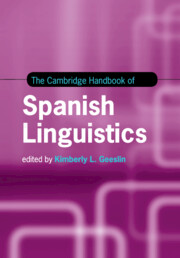Book contents
- The Cambridge Handbook of Spanish Linguistics
- Cambridge Handbooks In Language and Linguistics
- The Cambridge Handbook of Spanish Linguistics
- Copyright page
- Dedication
- Contents
- Figures
- Tables
- Contributors
- Acknowledgements
- Abbreviations
- Introduction
- Part I Theories and Approaches to Spanish Linguistics
- Part II The Spanish Sound System
- Part III Spanish Morphosyntax and Meaning
- Part IV Spanish in Social, Geographic, and Historical Contexts
- 21 Spanish in Contact with Other Languages and Bilingualism across the Spanish-Speaking World
- 22 Spanish as a Heritage Language in the US: Core Issues and Future Directions
- 23 Geographic Varieties of Spanish
- 24 Sociolinguistic Approaches to Dialectal, Sociolectal, and Idiolectal Variation in the Hispanophone World
- 25 National and Diasporic Spanish Varieties as Evidence of Ethnic Affiliations
- 26 Current Perspectives on Historical Linguistics
- 27 Grammaticalization
- Part V The Acquisition of Spanish
- Index
- References
26 - Current Perspectives on Historical Linguistics
from Part IV - Spanish in Social, Geographic, and Historical Contexts
Published online by Cambridge University Press: 13 August 2018
- The Cambridge Handbook of Spanish Linguistics
- Cambridge Handbooks In Language and Linguistics
- The Cambridge Handbook of Spanish Linguistics
- Copyright page
- Dedication
- Contents
- Figures
- Tables
- Contributors
- Acknowledgements
- Abbreviations
- Introduction
- Part I Theories and Approaches to Spanish Linguistics
- Part II The Spanish Sound System
- Part III Spanish Morphosyntax and Meaning
- Part IV Spanish in Social, Geographic, and Historical Contexts
- 21 Spanish in Contact with Other Languages and Bilingualism across the Spanish-Speaking World
- 22 Spanish as a Heritage Language in the US: Core Issues and Future Directions
- 23 Geographic Varieties of Spanish
- 24 Sociolinguistic Approaches to Dialectal, Sociolectal, and Idiolectal Variation in the Hispanophone World
- 25 National and Diasporic Spanish Varieties as Evidence of Ethnic Affiliations
- 26 Current Perspectives on Historical Linguistics
- 27 Grammaticalization
- Part V The Acquisition of Spanish
- Index
- References
Summary
- Type
- Chapter
- Information
- The Cambridge Handbook of Spanish Linguistics , pp. 582 - 602Publisher: Cambridge University PressPrint publication year: 2018
References
- 3
- Cited by



